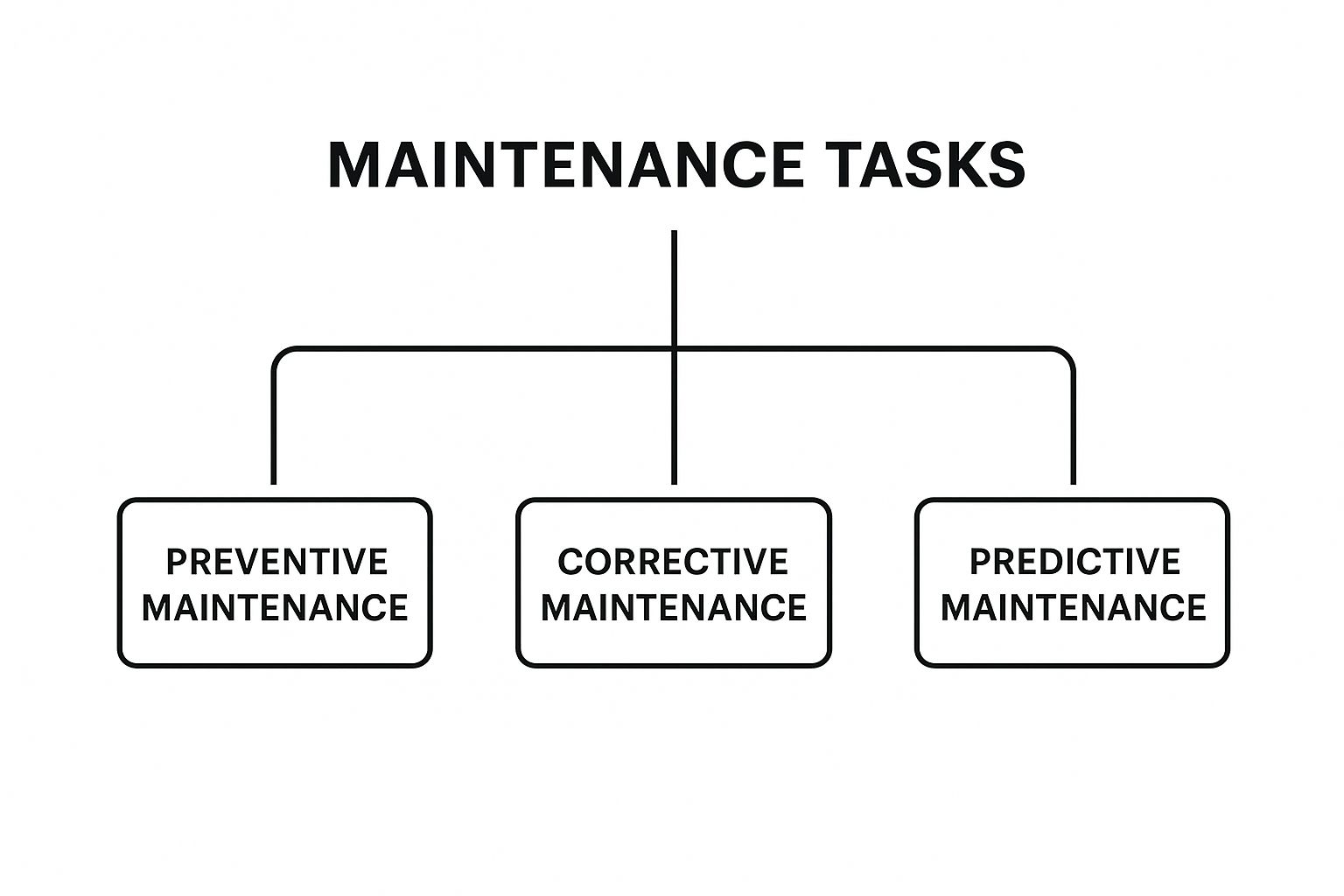Think of your website as a physical shop, perhaps on a busy street in Norwich or Cambridge. You wouldn't just open the doors and then leave it, would you? Of course not. You'd be cleaning, checking the locks, making sure the displays are tidy, and ensuring everything works as it should. Site maintenance services are simply the digital equivalent of that essential, ongoing care. It’s all the work that happens behind the scenes to keep your online presence secure, fast, and reliable for your customers.
What Are Site Maintenance Services?

Let's stick with that shop analogy. If your business is based in Norfolk or Suffolk, you know that first impressions count. A messy, slow, or broken website is the online version of a shop with a flickering sign, a jammed door, and dusty shelves. It doesn't inspire confidence.
Without regular maintenance, your website’s software becomes outdated, leaving security gaps that are an open invitation to hackers. Links break, pages slow to a crawl, and strange errors pop up. It all adds up to a frustrating experience that will send potential customers clicking away to your competitors.
The Core of Website Maintenance
Good website maintenance isn't about frantically fixing things when they break; it's about making sure they don't break in the first place. It’s a proactive strategy. Instead of facing a disaster—like your site crashing during your busiest season—a proper maintenance plan quietly hums along in the background, preventing problems before they start.
The table below breaks down the key tasks that are the bedrock of any solid maintenance plan.
Core Components of Site Maintenance at a Glance
| Maintenance Task | Purpose and Benefit |
|---|---|
| Security Monitoring | Constantly scanning for malware and vulnerabilities. It's like having a 24/7 security guard for your digital premises. |
| Performance Optimisation | Making sure your pages load quickly. This involves tasks like compressing images and fine-tuning server settings for speed. |
| Regular Backups | Creating full copies of your website's files and database. This is your ultimate safety net, ensuring you can restore your site quickly if the worst happens. |
| Software Updates | Keeping your CMS (like WordPress), themes, and plugins updated to their latest versions to patch security holes and improve functionality. |
Essentially, these four pillars work together to keep your website healthy, secure, and performing at its best for your visitors.
Neglecting website care is like ignoring a leaky roof in your store; a small, manageable issue today can quickly escalate into a major, costly disaster tomorrow. A well-maintained site is a cornerstone of customer trust and business continuity.
A Non-Negotiable Investment
For any small or medium-sized business in East Anglia, a website is a vital tool for generating leads, making sales, and building credibility. Because of this, professional maintenance isn't a "nice-to-have"—it's a fundamental business cost.
Slow performance can sink your search engine rankings, making it harder for new customers to find you. Even worse, a single security breach can shatter the trust you’ve worked so hard to build with your community.
Investing in a maintenance plan means you're safeguarding your most important digital asset. You can elevate your online presence with essential website maintenance services to see just how ongoing care drives real growth. It gives you the peace of mind to focus on what you do best—running your business—knowing your online shopfront is in safe hands.
The Five Pillars of Website Health
To really get your head around what professional site maintenance services bring to the table, it’s best not to see it as one single job. Instead, think of it as a combination of five distinct, essential pillars. Each one supports a vital part of your website’s health, making sure it stays a strong and dependable asset for your business.
Think of them like the core systems that keep your digital storefront not just open, but actually thriving.
This diagram shows how different maintenance tasks all play a part in your site's overall well-being.

As you can see, a solid maintenance strategy is a blend of proactive work (preventive), reactive fixes (corrective), and forward-thinking checks (predictive) to cover all the bases.
Pillar 1: Security – Your Digital Alarm System
Security is, without a doubt, the most critical pillar. Just as you’d lock the doors to your physical shop in Diss or Ipswich, your website needs tough digital locks. Without them, your site is a sitting duck for automated bot attacks, malware, and data theft, which happen thousands of times every single day across the web.
A proper security plan involves:
- Regular Malware Scans: Actively searching for and getting rid of any malicious code that might have snuck onto your site.
- Firewall Management: Building a strong barrier that blocks dodgy traffic before it even gets a chance to knock on your website's door.
- Vulnerability Patching: Closing known loopholes by applying security fixes the moment they’re released.
Ignoring security is like leaving your cash till wide open overnight. One breach can shatter customer trust and cause huge financial and reputational headaches.
Pillar 2: Performance – How Fast Your Doors Open
How long would a customer wait at a shop door that was jammed? Not very long. Website performance is the digital version of that. If your pages take an age to load, people will simply leave, often before they’ve even seen what you have to offer. Even a one-second delay in page load time can cause a serious drop in conversions.
Getting your site up to speed isn't a one-off fix; it's about constant care. For instance, a web agency might regularly compress the images for a Norfolk-based B&B. This ensures their beautiful photo gallery loads in a flash, directly improving the booking experience for potential guests. This pillar is all about speed and responsiveness, giving every visitor a smooth journey.
“Your website’s speed is the very first impression you make. A slow site hints at a business that’s inefficient or doesn’t care about its customers' time. A fast site, on the other hand, screams professionalism and a real commitment to a great user experience.”
Pillar 3: Updates – Keeping Your Technology Modern
Your website is built on a stack of software—things like WordPress, various plugins, and a theme. The developers behind this software are always improving it to add features, squash bugs, and, most importantly, patch up security holes.
It’s just like the operating system on your phone. You install updates to keep it running smoothly and securely. A single missed plugin update could be the exact weak spot a hacker exploits to get into your entire website. Good site maintenance ensures every component is kept current, protecting your site from threats you could have easily avoided.
Pillar 4: Backups – Your Insurance Policy
Even with the tightest security and the latest updates, disaster can still strike. A server could go down, a bad update could break your site, or simple human error could wipe out important content. This is when backups become your saving grace.
A dependable backup strategy includes:
- Regular, Automated Backups: Making complete copies of your website files and database on a set schedule.
- Off-site Storage: Keeping these backups in a separate, secure location so they won’t be affected if something happens to your main server.
- A Tested Restore Process: Making sure the backups actually work and can be used to get your site back online quickly, with minimal disruption.
Without a recent backup, you risk losing absolutely everything you've built.
Pillar 5: Uptime Monitoring – The Constant Patrol
Finally, you need to know the second your website goes offline. Uptime monitoring is an automated service that checks on your website constantly from different places around the world. If it can't reach your site, it immediately sends an alert to your maintenance provider.
This lets them jump on the problem and start fixing it right away, often before you or your customers even realise there’s an issue. It’s the 24/7 patrol that makes sure any problem is dealt with instantly.
Why Proactive Care Beats Reactive Repairs

Many businesses treat their website like a smoke alarm—they only pay attention when it’s making a racket. This reactive approach, waiting for something to break before fixing it, is a recipe for stress and unexpected bills. There’s a much smarter way: proactive care, where potential problems are identified and neutralised long before they can cause any real damage.
Let’s see how this plays out by looking at two small businesses here in East Anglia. One invests in a monthly plan for site maintenance services, while the other decides to "save" a bit of cash by crossing their fingers and hoping for the best.
The Story of Two Businesses
First, imagine "Norfolk Blooms," a thriving online florist. They've opted for a proactive maintenance plan. Every month, their website gets a full health check—software is updated, security is tightened, and its performance is tweaked. As a result, their site is always fast, secure, and ready for business, giving customers a smooth experience when ordering bouquets. Their costs are predictable, budgeted, and straightforward.
Now, let's turn to "Suffolk Crafts," a home décor shop that decided against a maintenance plan to keep costs down. For months, everything seems perfectly fine on the surface. But lurking behind the scenes, their out-of-date software has left a door wide open for trouble. One morning, they wake up to a business owner's nightmare: their website has been hacked and is now plastered with spam. Every minute it's down, they're losing sales.
The difference between these two paths, both financially and strategically, is stark.
A proactive maintenance plan is like servicing your car. You do it regularly to prevent a costly breakdown, keep it safe, and maintain its value. A reactive approach is like waiting for the engine to seize on the A14 before calling a mechanic.
The Cost of Waiting for Disaster
"Suffolk Crafts" is now in full-blown crisis mode. They have to scramble to find an expert for an emergency fix, which always comes at a premium. Business grinds to a halt. Every hour of downtime means more lost revenue and a growing list of frustrated customers. But the damage goes far beyond the immediate financial hit.
Here’s what the reactive business is forced to confront:
- Emergency Repair Costs: One-off, urgent fixes are almost always more expensive than a regular monthly retainer. You're paying extra for someone to drop everything and sort your emergency.
- Lost Revenue: Every minute your site is down is a minute you can't make a sale or capture a lead. For an e-commerce store, this can easily run into thousands of pounds.
- Reputational Damage: A hacked or broken website shatters customer trust. Shoppers will rightly worry their data is unsafe, and many simply won't come back.
- SEO Penalties: Google doesn’t like insecure or slow websites. A significant period of downtime can torpedo years of hard SEO work, making it much harder for new customers to find you.
Understanding the true cost of IT downtime really hammers home why proactive website care isn’t a luxury, but a necessity for business continuity.
The Lasting Benefits of Proactive Care
Meanwhile, "Norfolk Blooms" continues to grow without interruption. Their modest investment in site maintenance services is paying for itself many times over. Because their website is consistently fast and secure, their search engine rankings are climbing, bringing in more organic traffic. Their customers enjoy a reliable, professional shopping experience, which builds loyalty and encourages repeat business.
This principle is seen across the wider UK economy. The Infrastructure Maintenance Services industry, a vital sector with a market size of £14.1 billion, is dedicated to keeping the nation's physical and digital frameworks running smoothly. It just goes to show how critical preventative upkeep is for economic activity and safety.
Ultimately, the investment in ongoing care provides a clear and significant return. The parallels between maintaining physical infrastructure and your digital assets are undeniable. Exploring the key benefits of managed IT services can offer even more insight into how this forward-thinking strategy supports overall business health. Proactive maintenance isn’t just another cost—it’s a powerful strategy for sustainable growth.
The Future of Website Management Technology
The world of site maintenance services has moved a long way past manual checklists and putting out fires. We’re now seeing intelligent, automated systems taking over, turning website care from a necessary chore into a real strategic advantage. These technologies aren't just about making things easier; they bring a level of reliability and efficiency that used to be out of reach for most small and medium-sized businesses.
This change is happening everywhere, reflecting a much bigger shift across UK industries. Modern maintenance is now heavily influenced by digital tools and AI, which work to cut downtime and improve reliability. As a website owner, this trend works directly in your favour. It's fascinating to see how these trends are reshaping UK industries on mainstreamcommunity.com, and it’s easy to see the parallels with managing our digital assets.
The Rise of Predictive Maintenance
What if your website could tell you something was about to go wrong before it actually happened? That's the promise of predictive maintenance. By using artificial intelligence, today's maintenance systems can analyse data patterns from thousands of websites to get ahead of potential problems.
It’s a bit like having a weather forecast for your website. Instead of just telling you it's raining (i.e., your site is down), it warns you that there's a storm brewing on the horizon. For example, an AI might flag that a recently updated plugin has a high chance of clashing with your payment system, giving your maintenance partner a heads-up to sort it out before it ever affects your sales.
This proactive approach stops downtime in its tracks. It changes maintenance from a reactive, defensive job into a forward-thinking strategy that keeps your site stable and trustworthy.
Predictive maintenance shifts the focus from "what is broken?" to "what might break next?". By anticipating issues like plugin conflicts or server overloads, modern site maintenance services can prevent problems, saving you from lost revenue and emergency repair costs.
Digital Twins Perfecting Updates
One of the most exciting tools to emerge in website management is the digital twin. Simply put, a digital twin is an exact, fully functional copy of your live website. It runs in a private, isolated space, often called a "staging site." Think of it as your website's perfect clone.
So, why is this such a big deal? It makes testing completely risk-free.
Before any big change goes live—whether it's a major software update, a new feature, or a design refresh—it's first rolled out on the digital twin. This gives us several key advantages:
- Conflict Detection: It instantly shows up any potential conflicts or bugs in a safe environment where your customers won't see a thing.
- Performance Testing: It lets us measure how an update affects your site's speed and responsiveness before it ever goes public.
- Flawless Rollouts: Once everything has been thoroughly tested and signed off, the changes can be pushed to the live site with practically zero risk.
Using a digital twin means you never have to cross your fingers and hope for the best during an update again. It’s the closest thing to a guarantee that every change will improve your site without introducing new headaches.
Maintenance and Digital Sustainability
Here’s something you might not have considered: a well-maintained website is also a greener website. This idea, often called digital sustainability, is all about reducing the environmental footprint of our online world. A properly optimised site is a huge part of that.
When a website is fast and efficient, it demands less processing power from the server and uses less data for the person visiting it. This directly translates to less energy consumption in data centres and a smaller carbon footprint for your business online. Simple maintenance tasks like compressing images, cleaning up messy code, and streamlining databases all help make your website leaner and more environmentally friendly.
How to Choose the Right Maintenance Partner

Choosing someone to look after your website is a huge business decision. You're not just buying a service off the shelf; you're handing over the keys to a vital part of your business. For any small or medium-sized business in East Anglia, finding the right fit is a careful balancing act between technical know-how, local insight, and a genuine sense of partnership.
This choice has a direct impact on your website’s security, its speed, and its ability to bring in business. It's a serious responsibility. The UK's outsourced facilities management market, which includes digital site maintenance services, is worth over £35 billion. That number alone shows just how many businesses lean on expert partners to manage their assets. In fact, analyses predict this market will keep growing as companies seek smarter, data-driven ways to handle maintenance. You can explore the latest findings from CBRE to get a feel for these trends.
All this makes picking the right provider more important than ever.
Key Questions to Ask Potential Partners
Before you even think about signing a contract, you need to ask the right questions. This isn't about trying to trip them up; it's about making sure their way of working fits with what your business actually needs.
Here’s a practical checklist to guide your conversations:
- What happens in an emergency? Be direct. How do you report an urgent problem, what are their guaranteed response times, and is there someone available 24/7 if things go wrong? You have to know they’ll be there when it really counts.
- Can you show me work you’ve done for local businesses? Seeing their track record with other companies in Norfolk, Suffolk, or the wider East Anglia region is solid proof. It shows they understand the local market and can deliver results.
- What do your maintenance reports actually include? A good partner won't hide behind jargon. They’ll provide clear, easy-to-understand monthly reports detailing everything they've done—updates, security scans, performance checks, and backup confirmations.
- How do you handle website security? Go deeper than just a simple "we do security." Ask what specific tools they use for malware scanning, if they set up a web application firewall (WAF), and how they manage critical security patches.
- What’s your process for testing updates? You can't afford for an update to break your live site. The best providers use a 'staging site'—a private copy of your website—to test every single update before it goes live.
Freelancers vs Local Agencies
One of the first decisions you'll likely face is whether to go with a solo freelancer or a local agency. Each has its own strengths and weaknesses, and the right choice really boils down to your budget and what you need.
A freelancer often brings a more personal, one-to-one service and can be easier on the wallet. The flip side is that their availability might be limited, which could be a worry if you have an emergency.
An agency, on the other hand, gives you access to a whole team of experts. This means there’s always someone on hand to help, and they usually have a much broader set of skills, from security to SEO. While they might be a bigger investment, you're paying for reliability and a comprehensive service. For certain platforms, it's worth checking out dedicated providers; for instance, you can find out more about expert WordPress maintenance services in the UK to see what a specialised plan looks like.
Understanding Pricing Models
To avoid any nasty surprises on your invoices, it's essential to get a clear picture of how a provider charges for their work. This helps you budget properly and pick a plan that offers genuine value.
- Monthly Retainer: This is the most common model. You pay a set fee each month for an agreed list of services, like updates, backups, and security checks. It gives you predictable costs and encourages proactive care.
- Ad-Hoc (Pay-As-You-Go): With this approach, you only pay for work as and when you need it. It can be cost-effective for very basic needs but can get expensive fast in an emergency or if you need regular help.
- Tiered Plans: Many agencies offer different levels of service (e.g., Basic, Standard, Premium). This lets you choose a package that fits your website's complexity and your budget, with the flexibility to move up as your business grows.
Choosing a partner is more than a transaction. Look for a provider who is genuinely interested in your business goals and sees themselves as an extension of your team, dedicated to helping you succeed online.
As you weigh up your options, understanding the scope of their managed cloud services is also key to ensuring your website runs smoothly and reliably. Making a well-informed choice now will help you build a partnership that protects your digital presence and supports your growth for years to come.
Of course. Here is the section rewritten to sound more human and expert-led, while preserving all the core information, links, and formatting.
Your Top Website Maintenance Questions, Answered
Deciding to bring in a professional to look after your website is a big step. It’s totally normal to have a few questions before you commit. After all, this is about protecting one of your most important business assets.
Let’s walk through some of the most common queries we hear from business owners across East Anglia. My goal is to give you clear, straightforward answers so you can feel confident in your decision.
How Much Should I Expect to Pay for Site Maintenance?
This is usually the first question on everyone's lips, and the honest answer is: it really depends. The price tag for professional site maintenance services is tied directly to your website's size, its complexity, and the level of support you need. Think of it like a vehicle service plan – the needs and costs for a small family run-around are very different from those for a heavy-duty commercial lorry.
For a standard small business website, like one for a local tradesperson in Norfolk or a consultant in Suffolk, you can expect a basic monthly plan to be somewhere in the £50 to £200 range. This typically covers the absolute essentials: software updates, security scans, and regular backups.
If you’re running something more complicated, like an e-commerce shop or a site with custom-built features, you’ll naturally be looking at a higher investment. These plans often run from £200 to £500+ per month. That's because they involve more intensive work like performance tuning, advanced security monitoring, and having an expert on-call for priority support.
It's helpful to see this as an investment in business continuity, not just another bill. That monthly fee is almost always a tiny fraction of what it would cost to recover from a major hack, lengthy downtime, or a catastrophic data loss.
Can I Just Do My Own Website Maintenance?
The short answer is yes, you can. But the far more important question is, should you? While clicking an "update" button for a plugin might seem simple enough, the DIY approach comes with some very real risks, both in terms of time and technical know-how.
Proper website maintenance is so much more than just hitting 'update'. A professional knows the subtleties. They know which plugins are likely to clash after an update and, crucially, how to test everything on a safe staging site before making any changes to your live business front. They have the tools to spot and fix a problem in minutes that might take you hours, or even days, of frustrating online searches to solve.
You have to ask yourself: is your time better spent growing your business—seeing clients, creating products, leading your team—or frantically trying to figure out why your website has crashed? For nearly every business owner I’ve met, handing this off to an expert provides incredible value and, just as importantly, total peace of mind.
What Is the Difference Between Hosting and Maintenance?
This is a big point of confusion for many people, but the distinction is vital.
Here’s a simple analogy that usually clears it up:
- Web Hosting: Think of this as the plot of 'land' where your website 'house' is built. Your hosting company provides the physical server space that stores all your files and makes them available on the internet. Their job is to keep the power on and make sure the land is connected to the main road.
- Site Maintenance: This is all the ongoing 'upkeep' for the house itself. It’s about locking the doors and windows (security), making sure the plumbing and electricity work perfectly (performance), reinforcing the foundations (updates), and having good insurance (backups).
While some web hosts bundle in basic maintenance add-ons, these are rarely as thorough or proactive as what a dedicated maintenance specialist provides. Your host keeps your website online; a maintenance service makes sure it’s secure, fast, and working perfectly while it's there.
How Often Should Website Maintenance Be Performed?
For the vast majority of business websites, a monthly maintenance schedule is the industry standard. It creates a solid rhythm of protection and care, allowing for a comprehensive check of all your critical systems.
A typical monthly cycle looks something like this:
- Core, Theme, and Plugin Updates: Carefully applying all available software updates to patch security holes and improve how things work.
- Comprehensive Security Scans: Actively scanning the entire site for any sign of malware or suspicious files.
- Fresh Backups: Taking a brand new, complete backup of your site's files and database and storing it safely somewhere else.
- Performance Checks: Reviewing your site’s loading speed to catch any new bottlenecks that might have crept in.
That said, this isn't set in stone. A high-traffic e-commerce site or a website that’s absolutely central to your daily operations might benefit from weekly check-ins to stay in peak condition. And, of course, any critical security patches shouldn't wait for a monthly cycle—they need to be applied the moment they’re released to close dangerous loopholes.
Ready to stop worrying about your website and start focusing on your business? At Ibertech Solutions Limited, we provide expert site maintenance services designed for SMBs across East Anglia. Let's talk about securing and optimising your digital presence today.





